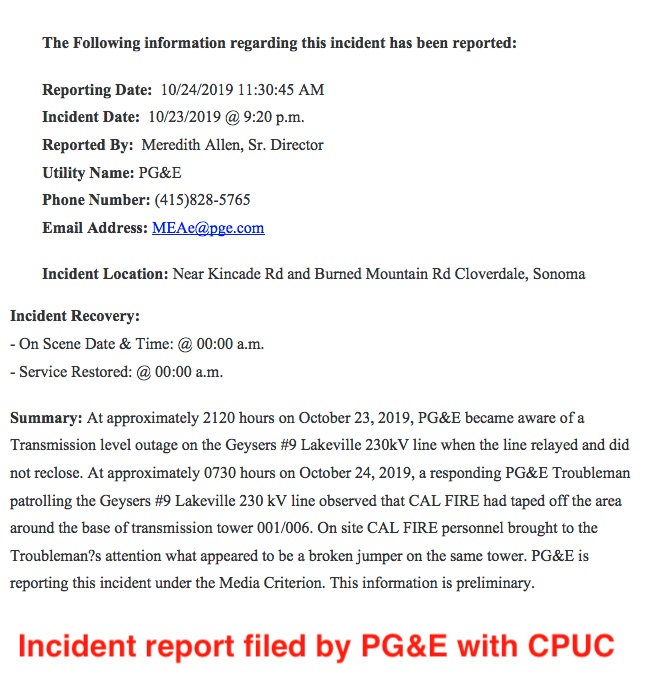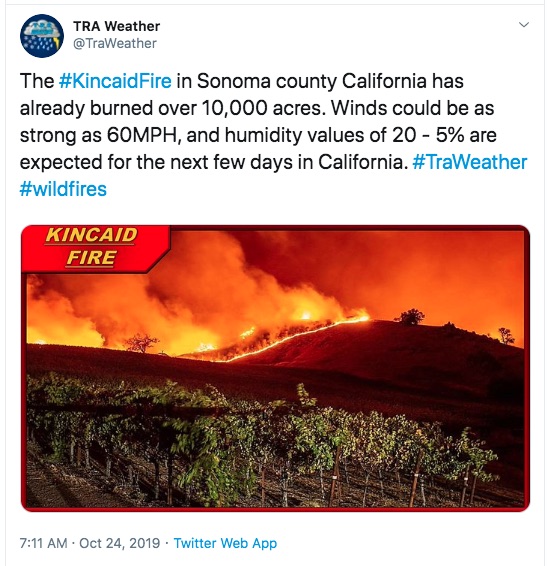California’s 2019 fire season is all set to surpass 2018’s massive wildfire that destroyed Paradise CA. Almost every year for the last 10 years there’s been a new biggest wildfire of California’s history, only to be beaten by the one a year later. Last year the Camp Fire was ignited by fallen PG&E power lines in the Feather River valley, then raced across the mountains to reach and destroy Paradise within one day. This year the Kincaid Fire was ignited in a very similar way, high winds causing a power line problem on PG&E’s power lines, apparently igniting a fire. And it’s not just the Kincaid Fire, but there are several wildfires burning in Southern California due to similar weather conditions.
One difference between 2018 and today is that California’s power regulators worked with the utility companies to develop a protocol for so-called Public Safety Power Shut-off Events. The goal was to detect weather conditions likely to cause problems involving electrical power lines and dry vegetation, and to shut off electricity so that even if a power line goes down it won’t spark a fire.
This is a Climate Change story, not a PG&E is Evil story
In the following we’ll learn that PG&E failed to follow the procedures it had designed that are meant to avoid such problems. The Kincaid Fire was ignited (preliminary information) at the location of a failed power line that was energized, despite being in an area where power was shut down. CalFire hasn’t done their investigation nor issued a report yet, so while the evidence looks damning, we cannot rightly blame PG&E right now.
But there is another larger aspect to this story. The terrain in California would not be a tinder box if it weren’t for the many years of drought conditions. That drought in turn is clearly caused by Climate Change.
While we cannot pin specific events on climate change, we can use that phrase to refer to long term trends over a large area. California’s climate/weather pattern has been extremely dry and much hotter over the last few years. In the past California’s rain fell in the Winter, filling the mountains with snow, and California has an extensive series of reservoirs to capture that water to use it throughout the year. But the last several years the winter rainfall was much lower than normal, causing California to run desperately short on water, and more importantly lots of vegetation died due to lack of water.
It’s not just Northern California, Southern California has several active fires at the same time. The largest of those is the Tick Fire, located at Tick Canyon Rd and Summit Knoll Rd, Canyon Country. It encompasses nearly 4000 acres at this time, is 5% contained, and is threatening to burn residential areas in the canyons.
As much as the following information will make you shake your fist at PG&E, know that it is a larger story. California is drying out because of ever-hotter climate patterns. California has a lot of beautiful landscapes full of trees and other vegetation, that are now tinder dry and ready to catch fire.
Scientists several years ago predicted that climate change would cause an increase in the frequency of large wildfires (and many other calamities). Here we are, California, facing an increased frequency of large wildfires.
PG&E and the CPUC develops Public Safety Power Shut-off Event protocol meant to avoid future wildfires
As we noted in November 2018, the Camp Fire (named because it started near where Camp Creek intersects with Camp Creek Road just north of Pulga CA) was ignited in such a condition. This location is extremely rugged terrain in the Feather River Canyon, with high voltage power transmission lines installed over 100 years ago on the cliff sides in this valley. The vegetation was already dry due to years of drought, and it being the end of the summer (California does not get rain during the summer). For several days before-hand, there’d been strong winds from the east that further dried the vegetation. PG&E was worried enough to send people around warning of a possible power shutdown, but in the end they did not shut down the power. So on the morning of November 8, 2018, with 50+ miles/hr winds blowing down the Feather River Canyon, when the power line failed it had electricity, which caused sparks, which ignited the vegetation, and the wind drove the fire across the mountains to destroy Paradise.
The PSPSE process was meant to prevent that scenario from recurring. But as we’ll see, PG&E failed to properly follow this process, and preliminary information says a failed energized PG&E power line caused this fire.
PG&E’s ham-handed use of the PSPSE protocol in October 2019
Earlier in October 2019 PG&E grew worried enough about weather conditions to announce a Public Safety Power Shut-off Event. Unfortunately the populace didn’t really understand what was going on, and their anger at having electricity shut off caused a heap of ill-will towards PG&E. It didn’t help that a man at home on a life support machine died within minutes of the power shut-off event because he couldn’t afford any kind of backup power system that would keep his life support machine running.
On October 15, 2019 PG&E issued a press release – Preliminary Review Confirms More than 100 Incidents of Damage and Hazard Locations; Photos Available Online, More Expected in Coming Days![]() . The title says it all, doesn’t it? A large company under fire from its customer base, issues a press release saying it was all great and wonderful. They cited several issues, primarily fallen tree branches that were tangled in power lines. We’re supposed to take from this that any of those could have been the start of a wildfire had those power lines been energized.
. The title says it all, doesn’t it? A large company under fire from its customer base, issues a press release saying it was all great and wonderful. They cited several issues, primarily fallen tree branches that were tangled in power lines. We’re supposed to take from this that any of those could have been the start of a wildfire had those power lines been energized.
On October 16, 2019, PG&E followed that up with: PSPS Wind Update: Wind Gusts in Nearly Two Dozen Counties Reached Above 40 MPH; in 15 Counties, Wind Gusts Topped 50 MPH![]() . As the title suggests it details wind conditions during the PSPSE in early October.
. As the title suggests it details wind conditions during the PSPSE in early October.
On the heels of that were several press releases warning of a similar wind condition event predicted on or around October 23, 2019.
- October 20, 2019: PG&E is Monitoring a Severe Wind Event Later this Week That Could Impact Portions of 17 Counties Across Northern and Central California

- October 21, 2019: PG&E Tracking Midweek Dry, Offshore Wind Event May Need to Proactively Turn Off Power for Safety in Portions of 15 Counties in Sierra Foothills and North Bay

- October 22, 2019: PG&E Continues to Track Dry, Offshore Wind Event for Wednesday/Thursday; May Need to Proactively Turn Off Power for Safety in Portions of 17 Counties: Sierra Foothills, North Bay and San Mateo and Kern Counties

- October 23, 2019: PG&E Moving Forward with Public Safety Power Shutoff in Portions of 17 Counties in Sierra Foothills, North Bay, Small Parts of San Mateo and Kern Counties

- October 23, 2019: PG&E Has Turned Off Power for Safety in Portions of 15 Counties in Sierra Foothills and North Bay

Don’t you get the idea that PG&E clearly knew that weather conditions were risky?
PG&E downed power lines trigger a fire despite a PSPSE covering the affected area

That report comes from Electric Incident Report Filed with CPUC in Response to Kincade Fire![]() . The press release has a lot more information, and it puts PG&E in a damning light. As promised by the press releases I linked to above, PG&E shut off power to customers in the area – “approximately 27,837 customers in Sonoma County, including Geyserville and the surrounding area”.
. The press release has a lot more information, and it puts PG&E in a damning light. As promised by the press releases I linked to above, PG&E shut off power to customers in the area – “approximately 27,837 customers in Sonoma County, including Geyserville and the surrounding area”.
That’s precisely the area where the Kincaid Fire is burning. The location of the power outage in PG&E’s incident report coincides exactly with the starting location of the Kincaid Fire.
PG&E’s press release goes on to say:
As part of the PSPS, PG&E distribution lines in these areas were deenergized. Following PG&E’s established PSPS protocols and procedures, transmission lines in these areas remained energized.
Those transmission lines were not deenergized because forecast weather conditions, particularly wind speeds, did not trigger the PSPS protocol. The wind speeds of concern for transmission lines are higher than those for distribution.
PG&E
The “high voltage” long distance transmission lines were not de-energized, while the “medium voltage” and “low voltage” lines serving run-of-the-mill consumers were shut down. The fire was triggered by a failure of the high voltage transmission lines, that PG&E did not feel were necessary to shut down.
A Sacramento Bee![]() report says the tower in the Kincaid Fire had been inspected several times over the last two years, that it was only 43 years old and that “It appeared to be in excellent condition” at the latest inspection.
report says the tower in the Kincaid Fire had been inspected several times over the last two years, that it was only 43 years old and that “It appeared to be in excellent condition” at the latest inspection.
The distribution lines are supposed to be shut off when wind gusts top 40 mph, while the transmission lines can handle 55 mph gusts, he said. Distribution lines run closer to trees and are considered more likely to cause a fire, PG&E said.
Sacramento Bee
This article says we should expect more of the same sort of weather over the next few weeks. California’s typical weather pattern is for rain to begin in late November, meaning we have another month or so remaining in 2019’s fire season.
- Is there enough Grid Capacity for Hydrogen Fuel Cell or Battery Electric cars? - April 23, 2023
- Is Tesla finagling to grab federal NEVI dollars for Supercharger network? - November 15, 2022
- Tesla announces the North American Charging Standard charging connector - November 11, 2022
- Lightning Motorcycles adopts Silicon battery, 5 minute charge time gives 135 miles range - November 9, 2022
- Tesla Autopilot under US Dept of Transportation scrutiny - June 13, 2022
- Spectacular CNG bus fire misrepresented as EV bus fire - April 21, 2022
- Moldova, Ukraine, Georgia, Russia, and the European Energy Crisis - December 21, 2021
- Li-Bridge leading the USA across lithium battery chasm - October 29, 2021
- USA increasing domestic lithium battery research and manufacturing - October 28, 2021
- Electrify America building USA/Canada-wide EV charging network - October 27, 2021













